Hey Doc! When Will I Feel Better?
As chiropractors, this is the number one question we get asked daily. Unfortunately, we don’t have a crystal ball to give our practice members an exact answer, but wouldn’t that be so awesome if we could? Although this is impossible for us to answer specifically, we do have some parameters and guidelines that could give you a ballpark timeframe in which you’ll get relief, but also some pointers to help move your healing forward faster and more efficiently. At HealthWorks Family Chiropractic, we believe that healing is a team effort, and we are your cheerleaders!
Factors that determine healing time
- Age: The older you are the more time your body has had to degenerate, and more so, the more time it has had to have damage from auto accidents, slips and falls, sports injuries, and, of course, stress!
- Fitness level: From couch potatoes to Cross Fit aficionados, we see them all. Everyone has their own challenges to healing and each is very unique.
- How long you’ve been in pain: Pain is typically the last sign that something is wrong when it comes to degenerative conditions of the spine. I can’t tell you how many people walk into our office and report doing something completely innocuous like picking up a pencil and all of the sudden not being able to get back up again. Did that injury happen just then or did the condition that set the stage for this “proverbial straw” occur years or possibly decades earlier?
- The type of injury or chronic condition(s) you have: Has it been a long-term and/or intermittent issue you’ve had, or did you just get hit by a baseball bat in the back of the head at your company co-ed game? What tissues were affected? Do you have comorbidities that cause underlying inflammation that would make healing more difficult and more time-consuming? These are questions that play into how well and effectively you can heal.
- Lifestyle factors: How much water do you drink? Do you exercise? Are you a fast food junky? Are you on multiple medications that have side effects contributing to your pain/condition? The way you treat your body on a daily basis will undoubtedly play into how fast or well you heal.
The main factors that determine your healing time can be in the multiples as you can see. Of course, we live in a microwave society and are used to things being done in 30-seconds or less. Unfortunately, this is not the way the human body heals. The fact is, it’s not that simple.
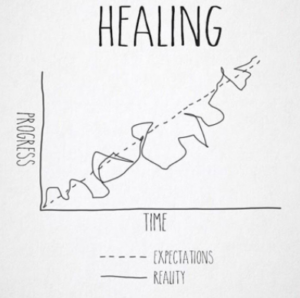
Healing progress chart
That’s probably not what you wanted to hear, but many factors go into the alignment and the recovery afterward. During your initial examination, HealthWorks Family Chiropractic will get an extensive history of your condition. We’ll need to know where your pain is and how long you’ve been dealing with your issue so we can come up with a clinical estimate on any damage to your spine.
This will include the mechanics of your spine, the curves of your spine, and the range of motion of your spine. There are extensive diagnostics that are taken on your initial visit to get to the underlying cause of your pain and condition. At HealthWorks Family Chiropractic, we never like to guess! The fact is, the vast majority of our cases are helped through chiropractic care, however, from time to time, we do have patients that come in and we find a situation that could best be handled by a medical professional. Some examples are vertebral fractures, aortic aneurysms, congenital anomalies, bone cysts, possible bone cancers, and infections, and even previous surgeries where the hardware has broken off! Although these instances are very rare, rest assured that HealthWorks Family Chiropractic will leave no stone unturned and make sure you are a candidate for chiropractic care through a careful and thoughtful diagnostic process before we ever get started with your first alignment.
Do you want to get out of pain or correct the problem that caused it in the first place?
Seems like a weird question. Of course, your main objective is to get out of pain! But, did you know that unless you treat the underlying issue, your pain will continually come back, and you will never get rid of the pain? Who wants to be on a roller coaster ride like that for the rest of their lives?? Not me!
Unfortunately, pain or lack of pain is not the greatest indicator of whether your problem has been corrected, the pain is usually the very first thing to go! Thank goodness! However, it typically provides a false sense that the problem is gone, when in actuality, correcting the cause is just in its infancy.
When joints are out of alignment and have been moving improperly for years it creates inflammation. Inflammation causes pain. Chiropractic adjustments restore proper motion and movement to the joints over time and reduce the inflammation and the pain starts to diminish. However, this is when the real work begins! Once the joints start moving properly, the proper structure of the spine the true cause of most spinal/back/neck issues can finally be addressed. So, the very worst time to stop chiropractic care is when you are finally out of pain!
Who do you think would have less pain, the picture on the left or on the right? Each adjustment builds on the next which creates stronger structure and better biomechanics every time.
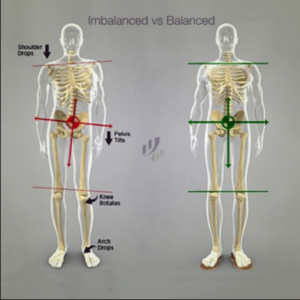
Imbalanced vs Balanced body
How many chiropractic adjustments does it take to feel better?
To completely understand your case, and how soon you will be feeling better, precision diagnostics provide the information as to where you are right now and where realistically we can take you on your health and healing journey. Without these parameters, it’s really just a guessing game and HealthWorks Family Chiropractic does not like to guess, if we haven’t said that numerous times before!
Many new patients get frustrated when they come to our office and they don’t get treated on the very first visit and that’s completely understandable. You’re in pain and you want to be treated NOW! However, would you like a surgeon to open you up without knowing where he needs to go or what is actually the problem? Hopefully, your answer is, NO!
HealthWorks Family Chiropractic has had a handful of cases in which we’ve had patients come in with seemingly chiropractic issues and once we do the complete diagnostic study, we find they have something that is out of our scope of practice or that needs to be evaluated first with another physician before they start care in our office. Rest assured that no matter what, HealthWorks Family Chiropractic will be sure you are a candidate for our care prior to your very first alignment!
X-Ray Imaging
X-rays are one of the most questioned by patients. We’ve been scared all our lives into thinking that X-rays are harmful and we should avoid them at all costs. Although I can understand this line of thinking, the science does not support that general spinal films, applied using a digital system, along with the lead filters we utilize, the radiation is reduced from 65-97% depending on the area imaged. https://eriksenchiropracticlaser.com/storage/app/media/xray-filters-021218.pdf
The CoreScore
The CoreScore evaluates the function of the nervous system. The spine and spinal nerves reside in the spinal column and therefore the evaluation of this function is crucial in finding out what nerves are irritated and what nerves are functioning well. This allows us to determine the cause of the problem and not simply chase your symptoms around.
Here’s an example of a CoreScore report:
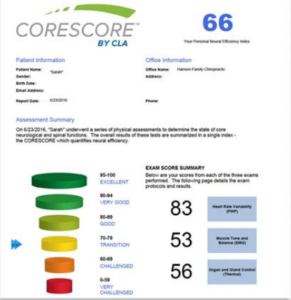
CoreScore report
What do the numbers mean?
Think of these numbers like grades; the higher the better, with 100 being the perfect score. We use these scans not only to find out where you are when you first come in, but how you are progressing during your course of care.
What is Heart Rate Variability (HRV)?
This scan shows us how well your body is able to adapt to external stressors-chemical, physical and emotional. In other words, how much ability you have to heal and change, and what kind of initial outcome we can expect.
What is a Surface EMG scan (sEMG)?
This scan called a Surface Electromyograph, reveals surface electricity and the variations from one level to the next. Subluxations cause changes in muscle tone that show up on this scan as changes in surface electricity. It determines how well the nerves to your muscles are functioning.
What is a Thermal Scan?
This scan measures heat along your spine. When misalignments are present, there can be a change in temperature from one side to the other (asymmetry), due to changes in blood supply. This helps us determine what nerves, that supply information to your organs and glands, may be inflamed and irritated.
Overall, CoreScore helps us determine the overall health of your nervous system. The nervous system is very elusive and where you feel the problem, may not be the cause. This, along with correlating your other diagnostics give us a great roadmap to determine the very best course of care for your individual case.
Posture/Palpation and Leg Check
I’ve gone extensively over how posture is so important when it comes to spinal health and well-being in previous blogs, so check those out too! Essentially, posture is the “window to the spine”. It allows us to see what muscle groups are functioning properly and which ones may be compensating depending on how you present. Here’s a great example of a before and after posture change after being under care:
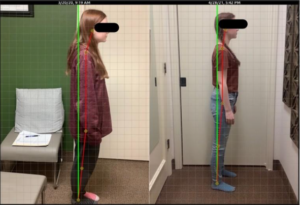
Side posture progress
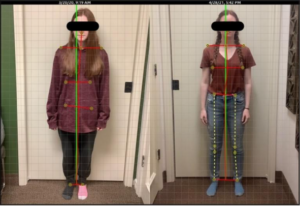
Front posture progress
Palpation is when the doctor feels your spine to determine what segments are moving and which ones are “stuck”. Vertebrae should rock evenly back and forth without any inflammation or tenderness around them. We also determine what muscles are more tense and tender, this feedback from you is a very important part of your case history.

Palpation
The Supine Leg Check is one of the first neurological signs that the very top bone of your spine, C1/Atlas is out of alignment. What!? What do you mean? What do your legs have to do with your spine? Let’s break this down. The atlas surrounds part of the brain stem. The brain stem controls many things like your breathing, heart function, and yes, your postural muscles. When the atlas is out of alignment, it puts subtle pressure on the brain stem causing it to send aberrant information to the postural muscles, like a muscle spasm on one side of your body that torques your hip and pulls your leg up. This makes it look like you have a “short leg”.
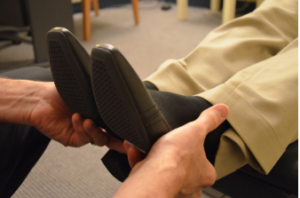
Supine Leg Check
These diagnostics provide us with the very best clinical knowledge to guide you throughout your corrective care. Although it’s impossible to give you a date and time as to when the pain will go away, these tests will provide us with the information we need to recommend the very best detailed program to get you back on track with your health and get you back to living!
Our promise to you
HealthWorks Family Chiropractic is dedicated to a comprehensive and specific approach to taking care of spinal and nervous system needs. Let us help you find out how taking care of the most important system in the body will create optimal health that will last a lifetime!
If we find we’re not the best to help, we promise to refer you to someone who is